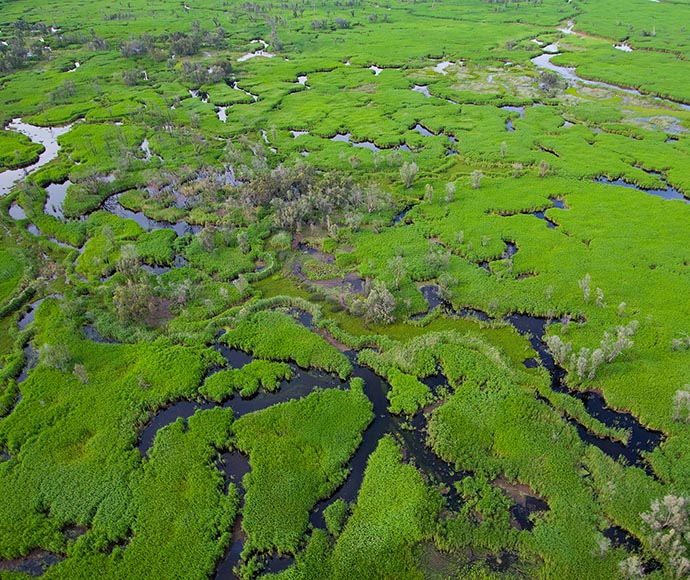The Macquarie Marshes Ramsar site covers 19,850 hectares and lies about 100 kilometres north of Warren in central west New South Wales. The marshes consist of 3 subsites:
- Macquarie Marshes Nature Reserve, which was listed as a Ramsar site in 1986
- part of the Wilgara grazing property, which was added in 2000
- U-block (also part of a grazing property), which was added in 2012.
Why these wetlands were listed as a Ramsar site
Countries that sign up to the Ramsar Convention can nominate sites to be listed as Wetlands of International Importance (Ramsar sites). The site must meet at least one of 9 internationally accepted criteria.
The Macquarie Marshes were listed as a Ramsar site because they meet the following criteria.
Criterion 1: Representative or unique wetlands
The Macquarie Marshes are one of the largest remaining inland, semi-permanent wetlands in the Murray–Darling Basin and have a high diversity of wetland types.
This Ramsar site is an example of a wetland that relies on runoff from a high-rainfall upper catchment. The Macquarie Marshes site has extensive and changeable wetlands in its semi-arid lowland reaches.
Criterion 2: Threatened species or ecological communities
The Macquarie Marshes support 4 internationally threatened species on the International Union for Conservation of Nature (IUCN) Red List and 3 nationally threatened species:
Criterion 3: Populations of plants and/or animals important for maintaining biodiversity of a particular bioregion
The Macquarie Marshes contain a variety of habitat types, and consequently the plant and animal species of the site are particularly diverse. The marshes support extensive river red gum woodlands, which provide habitat for waterbirds and woodland birds, common reed and water couch marsh.
The Ramsar site is a key habitat for several plant and animal species, including Gould's long-eared bat.
Criterion 4: Supports species at a critical stage of their life cycle or provides refuge in adverse conditions
The Ramsar site represents highly significant habitat for waterbirds that breed in colonies. It is one of the few remaining sites in Australia supporting large breeding colonies of the straw-necked ibis, and one of only a few sites in New South Wales where magpie geese breed.
It also supports some of the largest breeding colonies of the intermediate egret, rufous night heron and royal spoonbill in the Murray–Darling Basin. The site has a rich diversity of other waterbirds, including cormorants, herons, spoonbills and ducks, many of which breed within the marshes.
Criterion 5: Supports 20,000 or more waterbirds
The Macquarie Marshes regularly support more than 20,000 waterbirds, and more than 500,000 birds when there are large floods. It supports breeding for 16 colonial nesting waterbird species, including substantial numbers of cormorants, herons, ibises and spoonbills.
Criterion 8: Food source, nursery or migration path for fish
The native fish community of the Macquarie Marshes is a blend of those found in nearby main channel habitats. During flows, fish are likely to move into the marshes from these areas.
How the site is managed
Management of this Ramsar site is guided by the following:
- the site’s Ramsar information sheet
- its ecological character description
- a plan of management for Macquarie Marshes Nature Reserve
- wetland management plans for the Wilgara property and for U-block – these adopt the Ramsar Convention’s ‘wise use’ principles
- the Macquarie Marshes Adaptive Environmental Management Plan
- the Macquarie Marshes Ramsar Site Article 3.2 Response Strategy.
Article 3.2 Response Strategy
In 2009, a notification of likely change in the site’s ecological character was submitted to the Ramsar Secretariat, under article 3.2 of the Ramsar Convention.
This came after a prolonged drought. The ‘likely change’ can best be described as a change from a semi-permanent to an ephemeral wetland system. The primary cause was found to be changes to the flow regime resulting from river regulation and extraction.
The Department of Climate Change, Energy, the Environment and Water, together with other agencies and managers, developed the Macquarie Marshes Ramsar Site Article 3.2 Response Strategy to deal with the decline in the wetlands and to help restore the system to good health.
The department has commissioned a project to review the response of the Macquarie Marshes Ramsar site and determine whether the site is showing signs of recovery in its ecological character.
Threats to the Ramsar site
The main threats to this site’s ecological character include:
- climate change
- alteration of the natural flow regime through river regulation
- dryland salinity in the catchment
- fire management
- pest management
- channel erosion.
